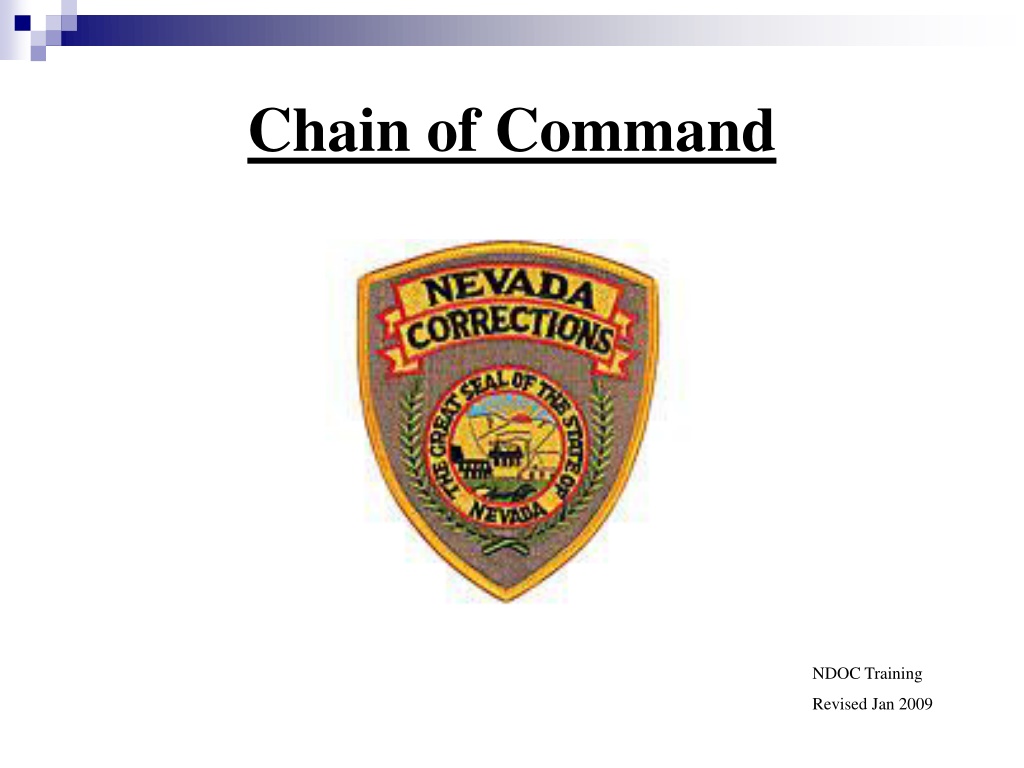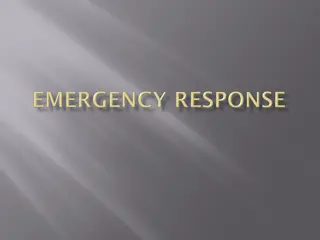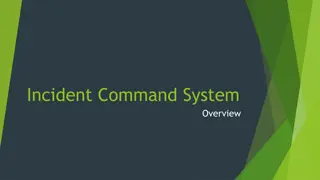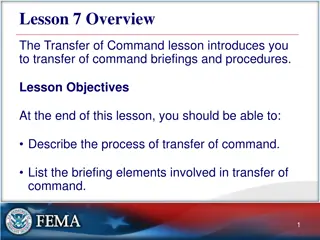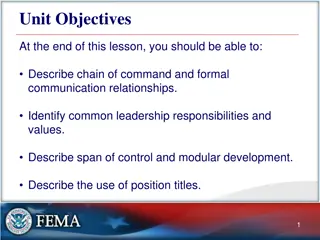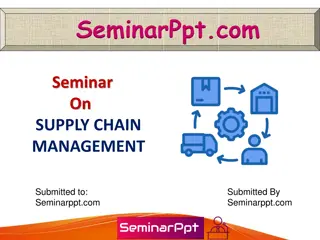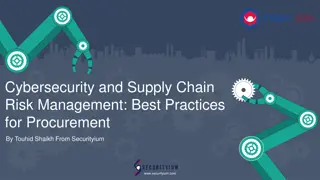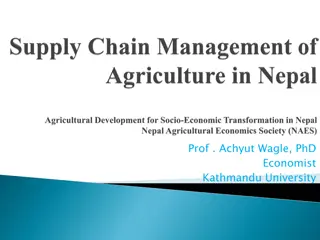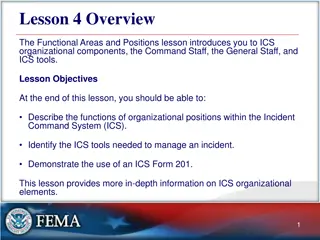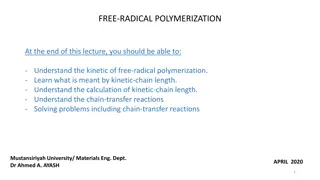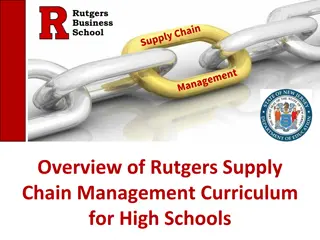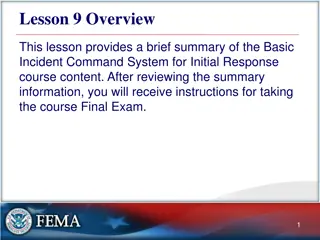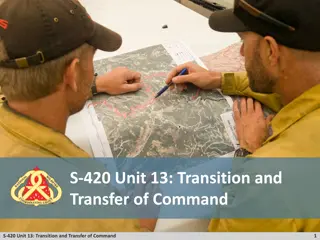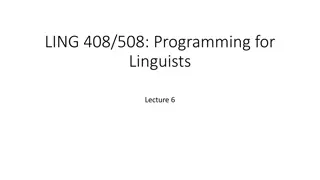Understanding the Importance of Chain of Command in NDOC Training
Explore the concept of chain of command in NDOC Training, including authority, responsibility, and accountability. Learn about the position of authority, ranks within the organization, and the significance of maintaining a structured hierarchy for effective operations. Discover why a chain of command is vital for maintaining order, security, and direction in groups.
Download Presentation

Please find below an Image/Link to download the presentation.
The content on the website is provided AS IS for your information and personal use only. It may not be sold, licensed, or shared on other websites without obtaining consent from the author. Download presentation by click this link. If you encounter any issues during the download, it is possible that the publisher has removed the file from their server.
E N D
Presentation Transcript
Chain of Command NDOC Training Revised Jan 2009
Authority The right or privilege of an individual to perform some action, to require others to perform some action, or to make certain kinds of decisions.
Responsibility An obligation for a person to perform the authorized duty, to observe the limits or restriction set by the organization, and to serve the public need or purpose for which the authority has been granted.
Accountability Each individual or group in an organization may be called upon at any time to show that they have exercised their authority and responsibility properly.
Position of Authority The position within the NDOC organizational structure which has been designated with authority, responsibility and accountability for assigned and/or specific duties relating to the NDOC s daily operations.
Rank/Insignia Name the Rank: Associate Warden of Operations Name the Rank: Correctional Lieutenant
Rank/Insignia Name the Rank: Correctional Sergeant Name the Rank: Senior Correctional Officer
Rank/Insignia Name the Rank: Correctional Officer
What Is The Chain Of Command? A chain of command is a direct line of authority and responsibility along which orders are passed. This is sometimes called a hierarchical structure in the civilian sector. Generally, orders are passed from higher ranking staff to lower ranking staff.
Why do we need a chain of command? In nature there is a tendency in groups for one creature to dominate others. As humans, we seek a sense of belonging. Groups provide security, order, a sense of purpose and direction. Even in informal groups a hierarchical structure will develop.
Why Do We Need A Chain Of Command? NDOC is a paramilitary organization. With over 3,000 employees structure is vital. To ensure that the NDOC s tasks and assignments are completed without confusion or wasted time and effort. So that everyone knows what their responsibilities are.
Why Do We Need A Chain Of Command? So that everyone is accountable to someone else for their actions. To provide a sense of direction. To ensure clear communications.
Unity of Command The theory that subordinate in an organization must be accountable to one and only one superior. This is sometimes referred to as having one boss . It s important to know who s in command of a situation.
Unity of Command Unity of Command exists to prevent a subordinate from receiving conflicting instructions from different supervisors which could lead to confusion and paralysis.
Dual Supervision When two superiors in separate chains of command provide dual supervision to a subordinate with specific responsibility.
Coordination and Span of Control Coordination is most effective when the lines of authority, responsibility, and accountability are clearly defined. Span of control is the number of subordinates or elements within an organization that are accountable to one superior.
Span of control No fixed number, but 7 10 is generally the accepted rule. Routine type work can increase span of control. Highly motivated or trained workers can also increase span of control. Character of the manager.
Who Are They? NDOC Director Interim E.K Mc Daniel Deputy Directors Dwight Neven (Interim) Sheryl Foster (Programs- South) Brian Connett (Prison Industries) Scott Sisco (Fiscal)
Who Are They? Nevada State Prison This Facility was closed down in May 2012. Still has an active death chamber.
Who Are They? Northern Nevada Correctional Center Warden- Isidro Baca AW- Ron Schreckengost AW- Brian Ward
Who Are They? Warm Springs Correctional Center Warden Harold Wickham AW Lisa Walsh ASO Joy Grimmer
Who Are They? Lovelock Correctional Center Warden Quentin Bryne AW William Sandie AW Terra Carpenter
Who Are They? Southern Desert Correctional Center Warden - Brian Williams AW Frank Dressen AW Minor Adams
Who Are They? High Desert State Prison Warden- Bruce Stroud (Interim) AW- Timothy Filson AW- Jerry Howell AW- Jennifer Nash AW- Jeremy Bean
Who Are They? Florence McClure Women's Correctional Center Warden- Jo Gentry AW- Gary Piccinini AW- Gabriela Garcia
Who Are They? Ely State Prison Warden- Renee Baker AW- Mike Byrne AW- William Gittere
Summary Some people don t see the need for a chain of command To succeed in the NDOC or other paramilitary type organizations you must learn and follow the chain of command. To not do so can lead to unnecessary conflict and loss of productivity.
